
Here are this year’s winners, selected by editors of Electronic Products:
- Amphenol ICC (Interconnects)
- Bosch Sensortec (Sensors)
- Cornell Dubilier (Passives)
- CUI (Electromechanical)
- Lumileds (Optoelectronics)
- Microchip Technology (Digital ICs)
- Nordic Semiconductor (RF/Microwave)
- Renesas (MPUs/MCUs)
- SiTime (Analog/Mixed-Signal ICs)
- Texas Instruments (Power)
(To view all of the finalists in each category, please click here.)

Amphenol ICC
OSFP Interconnect System
www.amphenol-icc.com
Designed from the ground up for higher speeds, the OSFP IO system from Amphenol ICC is an industry-standard eight-transmission lane-based connector, cage and cable (copper and optical) interconnect system. What’s significant is that it is designed to support present and future aggregate per port bandwidth needs from 200G and 400G to 800G and takes into account the requirements of mechanical robustness, electrical performance, and thermal management.
Key features include:
- 200G or 400G aggregate bandwidth capacity; dual eight-pair or single 16-pair wire supported
- 15-W single-port dissipative heat capacity
- EEPROM in cable assembly
- 32 AWG–26 AWG cable sizes
- Integrated heat sink and airflow channels as part of module design
- Double-ended as well as splitter cables
In addition, the highly integrated system features a complete I/O system that offers fully shielded connectors and cages in multiple configurations (ganged and stacked) that accept both copper-based and optical-based interconnect components (cables, transceivers, etc.) as well as passive and active copper cables and active optical cables (AOC). Because the system design addresses the necessary mechanical, electrical, and thermal requirements, designers can plug in short-length (cables) or short-range/long-range optical transceivers without worrying about proper system thermal management or the capability to accept any of the media.
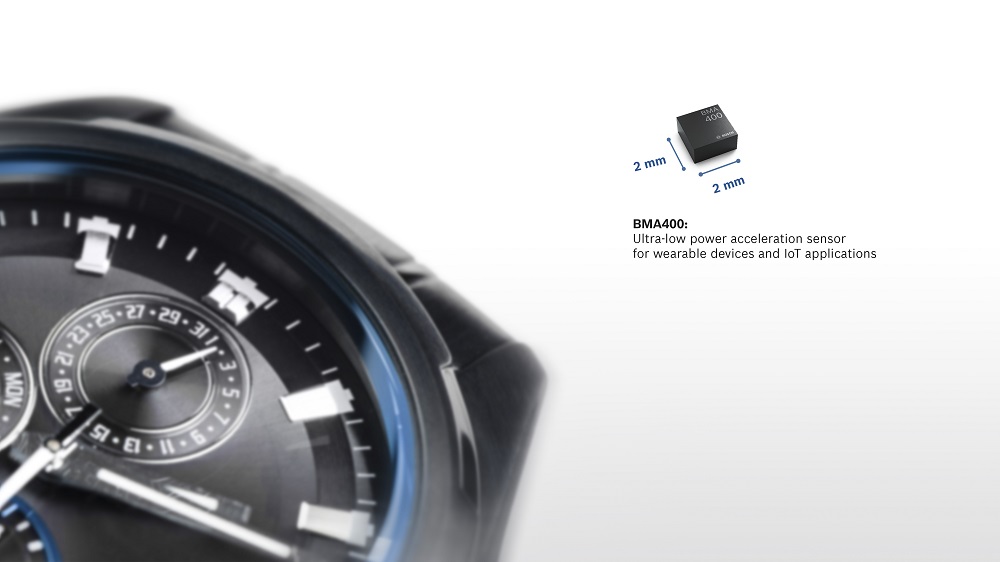
Bosch Sensortec
BMA400 Accelerometer
www.bosch-sensortec.com
Bosch Sensortec’s BMA400 , an ultra-low-power acceleration sensor for wearables and IoT applications, draws 10× less current than existing accelerometers while delivering solid high performance. Its greatly reduced power demand significantly extends battery lifetime, especially on coin-cell–powered devices.
Usually, accelerometers have to choose between low power and high performance. The ultra-low-current step counter, which draws only 4 μA in combination with intelligent power management features like built-in activity recognition, helps extend battery life. Further extending battery life, the BMA400 wakes up automatically only when it detects motion and goes back into sleep mode when the motion stops.
The BMA400 has a current consumption of 14 μA at the highest performance, continuous measurement, and a noise density of 220 μg/√Hz. This drops to 1 μA and below in the ultra-low-power self-wake-up mode.
Key features include:
- Measurement range: ±2 g, ±4 g, ±8 g, ±16 g
- 12-bit digital resolution
- Output data rate (ODR): 12.5 Hz to 800 Hz
- Current consumption: Max. performance — 14.5 μA; typical use case — 5.8 μA;
low-power use case — 3. 5μA - Noise density: Max. performance — 180 μg/√Hz (Z: x 1.45); typical use case — 300 μg/√Hz (Z: x 1.45); low-power use case — 415 μg/√Hz (Z: x 1.45)
- Auto wake-up mode: 800 nA @ 25 Hz ODR
- Embedded features: Step counter ( <4 μA overall), activity recognition (walking, running, standing still), activity change, orientation, tab/double tab (<8 μA overall), general interrupt 1 and 2 (programmable via thresholds, timer, logical AND/OR operations) and 1-kB FIFO
- Supply voltage: 1.71 V up to 3.6 V
Due to continuous measurement, the sensor’s high-quality measurement signal has precisely defined cutoff frequencies, making it very resistant to vibration. This is particularly useful in IoT use cases such as smart home security systems, in which the BMA400 can distinguish between real alarm situations like broken glass and false signals coming from random vibrations. This prevents false alarms being triggered from the outside environment.
The combination of a small package size of 2.0 × 2.0 × 0.95 mm³ and the integrated plug-and-play step counter make the BMA400 easy to design into a variety of wearables, including opening up new opportunities for traditional watches and jewelry. The device also includes a built-in voltage regulator and flexible device tuning for power consumption, noise, and ODR parameters.
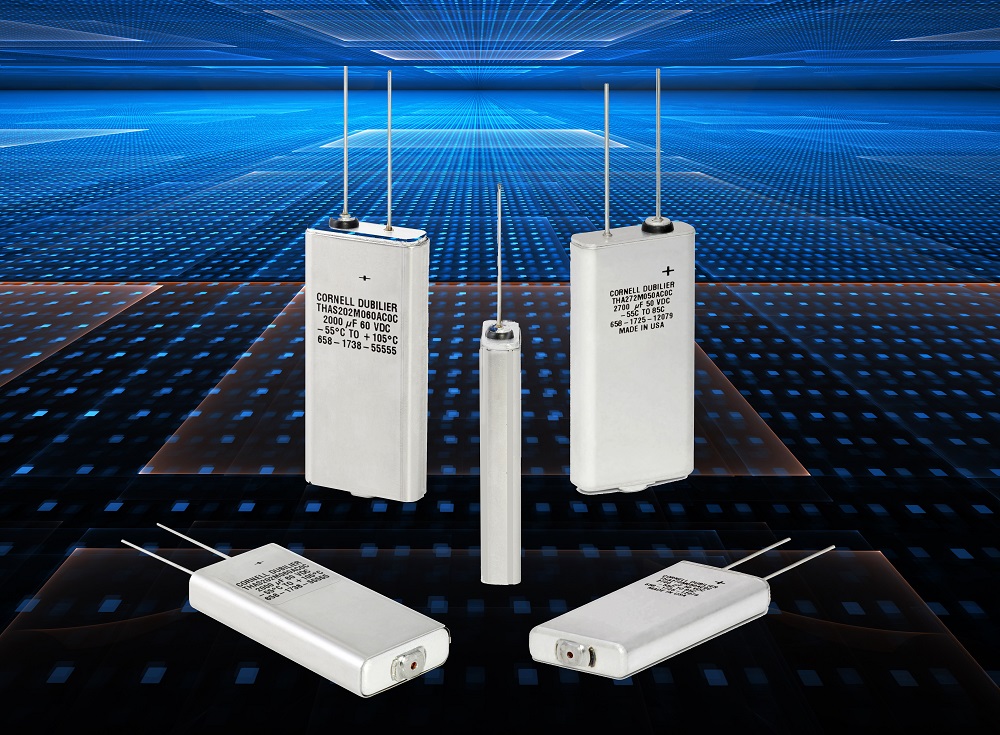
Cornell Dubilier
THA Series Thinpack Aluminum Electrolytic Capacitors
www.cde.com
Cornell Dubilier Electronics, Inc. (CDE) has announced a new development in aluminum electrolytic technology, delivering very high density in thin-profile packages. Featuring thin profiles, the 85°C THA Series Thinpack capacitors are only 8.2 mm thick, while the 105°C THAS Series offers a 9-mm profile. This is comparable in height to V-chip electrolytics, tantalums, and board-mounted axials but with a much higher bulk-storage capability.
The THA/THAS devices offer very high energy density up to 1.1 J/cc and up to 0.9 J/cc, respectively. The capacitance range for both series is 60 µF to 18,000 µF with a ±20% tolerance. Each series offers 72 capacitance/voltage combinations.
The operating temperature range for the THA caps is –55°C to 85°C (3,000-hour life @ 85°C), while the THAS devices offer an extended range up to 105°C (3,000-hour life @ 105°C). Unlike traditional cylindrical electrolytics, the THA/THAS capacitors have a sealed, laser-welded aluminum case, which eliminates the need for end-seal gaskets, providing up to a 60% space reduction.
A single THA/THAS capacitor can replace an array of SMT, axial or radial aluminum electrolytic, or solid tantalum capacitance arrays. That substitution can allow engineers to design smaller products with simplified assembly and higher reliability. In most applications, there are significant cost, weight, and space savings versus a comparably rated bank of SMT or axial aluminum electrolytic capacitors, said CDE, which can deliver a board space reduction of 70% as well as improved overall circuit reliability thanks to the smaller part and connection counts.
Re-engineered to be thinner and more cost-effective, the THA/THAS capacitors are a good fit for a variety of high-performance electronics, including tablets, laptops, instrumentation, commercial-grade LED driver modules, compact power supplies, drones and RPVs, set-top boxes, and 1U rack-mounted devices.

CUI
AMT21 and AMT23 Absolute Modular Encoders
www.cui.com
CUI’s AMT21 and AMT23 series are rugged, high-accuracy absolute modular encoders that output 12 bits or 14 bits of absolute position information. The AMT21 series, featuring high-speed RS-485 communication, and the AMT23 series, designed with a synchronous serial interface (SSI), are based on CUI’s proprietary capacitive sensing technology.
The capacitive platform offers an accurate position feedback solution that is resilient to dirt, dust, and oil typically encountered in industrial applications. The devices offer low current draw of 8 mA at 5 V and accuracy of ±0.2 mechanical degrees, making them well-suited for battery-powered industrial, robotics, and automation applications.
Key features include:
- 12-bit absolute (4,096) position or 14-bit absolute (16,384) position
- RS-485 (AMT21) or SSI (AMT23) communication
- Resilient to dirt and dust
- Low current draw
- Modular locking hub design for simple assembly
- One Touch Zero set
- –40°C to 105°C temperature range
- Compatible with AMT Viewpoint GUI
Both models, housed in packages as small as 1.53 × 1.12 × 0.40 inches (39 × 28 × 10 mm), also come with a locking hub for easy installation. They are also available in either radial or axial orientations. The operating temperature range is –40°C to 105°C.
The AMT21 and AMT23 encoders also are highly customizable and configurable, with the ability to program the direction of rotation and zero position via CUI’s AMT Viewpoint software. The design of the encoders also reduces the time that it takes to mount and align (to seconds) thanks to the One Touch Zero feature.
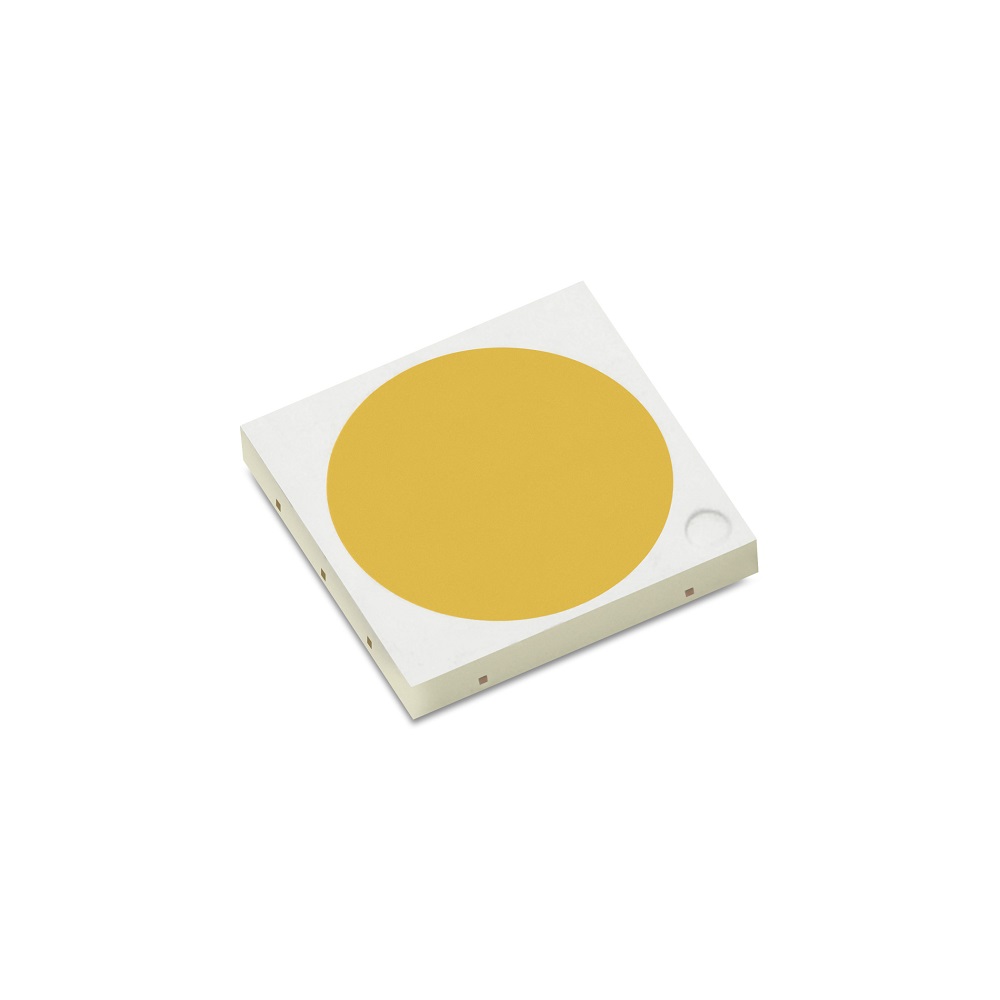
Lumileds
LUXEON 5050
www.lumileds.com
Lumileds introduced an upgraded LUXEON 5050 that sets the standard for high lumens per watt (lm/W) for high-bay and street-lighting applications. The LUXEON 5050 features the best performance of all multi-die emitters on the market, according to Lumileds, reaching flux levels of 350 lm and 175 lm/W at 2-W LED drive conditions (4,000K, 70CRI at 85°C).
But the advantage goes beyond superior flux, said Lumileds. The round LES (4.6 mm) eases optic design. With the industry’s lowest thermal resistance (2K/W), the LUXEON 5050 further enhances performance by removing heat and reducing heat sink requirements.
The LUXEON 5050 is available in a range of color temperatures (2,700K–6,500K) and CRI levels (70, 80, 90) to meet a variety of high bay and street lighting as well as indoor spotlighting.
Key features include:
- Small LES (4.6 mm)
- Enables highest-efficacy system design by driving at low current
- Hot-color targeting ensures that color is within ANSI bin at 85°C
- Binned within three-step and five-step MacAdam ellipse, ensuring color uniformity
- Compatible with low-cost and high-efficacy drivers
Typically for high-lumen fixtures that require a high lm/W, a group of standard mid-power LEDs would be used. By using the LUXEON 5050, it enables an overall smaller system, which can reduce the size and weight of the fixtures. With newly released LM-80 reliability data, the product also meets DLC Premium V4.1 requirements, giving fixture manufacturers access to high utility rebates and energy savings.
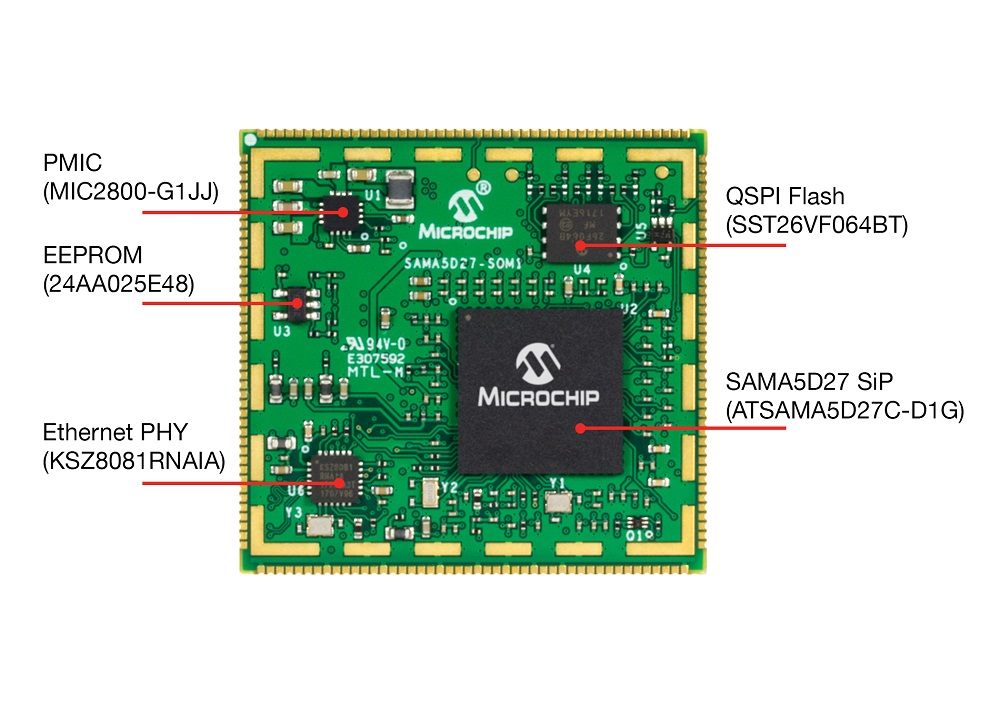
Microchip Technology
SAMA5D2 System-on-Module
www.microchip.com
There is extensive design effort and complexity associated with creating an industrial-grade MPU-based system running a Linux operating system, said Microchip, and even experienced developers spend a lot of time on PCB layout to guarantee signal integrity for the high-speed interfaces to DDR memory and Ethernet PHY while complying with EMC standards.
The SAMA5D2 system-on-module (SOM) simplifies design by integrating the power management, non-volatile boot memory, Ethernet PHY, and high-speed DDR2 memory on a small, single-sided PCB. Microchip’s SAMA5D2 SOM is a single-sided PCB with 169 components including the Arm Cortex-A5–based SAMA5D2 SiP that integrates DDR2 memory in a single package, simplifying designs by removing high-speed memory interface constraints from a PCB.
All of Microchip’s Linux development codes for the SAMA5D2 SiP and SOM are mainlined in the Linux communities, so customers can connect external devices with minimal software development. The SOM1-EK1 development board provides an evaluation platform for both the SOM and the SiP.
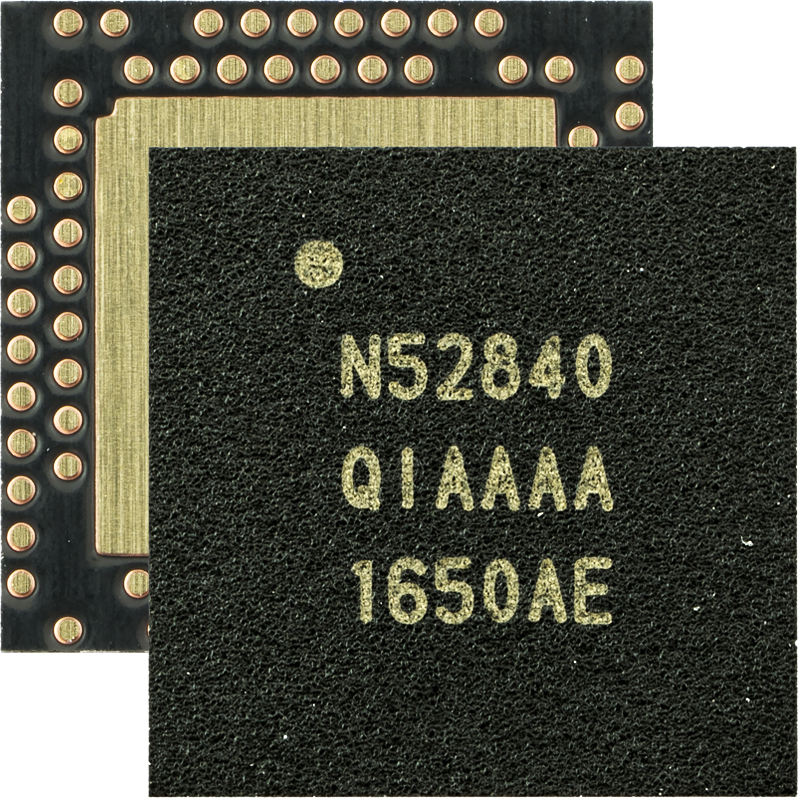
Nordic Semiconductor
nRF52840 Bluetooth Low Energy System-on-Chip
www.nordicsemi.com
Nordic Semiconductor’s nRF52840 Bluetooth Low Energy (BLE) System-on-Chip (SoC) — the high-end variant of Nordic’s nRF52 Series of high-performance Bluetooth 5-certified SoCs — brings a production-ready, multiprotocol wireless IoT solution to market with full Bluetooth 5 support and support for Bluetooth mesh and Thread.
The SoC offers the capabilities and flexibility to support a broad range of networked, connected products for wearables, gaming, VR/AR, and home and industrial IoT applications thanks to a wide range of features and peripherals.
The high-end nRF52840 SoC, based on Nordic’s proven nRF52 Series architecture, is the first single-chip solution to bring all of the benefits of Bluetooth 5 to the market. The key advantages of Bluetooth 5 compared with previous implementations of the BLE specification include: 2× on-air raw data bandwidth (2 Mb/s); 4× range; 8× broadcasting ability with advertising extensions that increase the advertising packet payload size to 251 bytes; and an improved channel coexistence algorithm.
The nRF52840 SoC uses a 64-MHz, 32-bit Arm Cortex M4F processor, floating point, and DSP performance to meet the demands of challenging wireless applications. The SoC can also operate from power supplies above 5 V, such as rechargeable battery power sources.
Other features include a new radio architecture with a +8-dBm on-chip PA, 1-MB flash and 256-kB RAM, IEEE 802.15.4 (including Thread), ANT, Zigbee, and proprietary 2.4-GHz wireless technologies; a full-speed USB 2.0 controller; and a host of peripherals including a quad-SPI interface. In terms of security, the SoC incorporates an Arm CryptoCell-310 cryptographic accelerator. Extensive crypto-ciphers and key generation and storage options are also available.
The nRF52840 SoC is the only multiprotocol device on the market today to offer concurrent Bluetooth 5 and Thread support, according to the company. The capability is enabled by the SoC’s BLE and Thread “Dynamic Multiprotocol” feature, which allows simultaneous support of the S140 SoftDevice and OpenThread RF protocol stack.
Nordic released the S140 SoftDevice (Nordic’s latest RF Bluetooth 5-certified protocol software, or “stack”), and a new version of Nordic’s nRF5 Software Development Kit (SDK), a production-ready development tool with full peripheral driver support for the nRF52840 SoC. For developers building Bluetooth mesh applications, the nRF52840 is supported by the production-grade nRF5 SDK for Mesh.

Renesas Electronics
RZ/A2M Microprocessor
www.renesas.com
The Renesas RZ/A2M microprocessor is designed for embedded AI-based imaging in smart appliances, service robots, and industrial machinery that require high-speed image processing. It features a unique hybrid approach to image recognition or machine vision by combining the company’s proprietary dynamically reconfigurable processor (DRP) technology for fast pre-processing of image data closely coupled to an Arm Cortex-A9 CPU with large on-chip RAM for AI inferencing. The upshot: The RZ/A2M MPU delivers real-time image processing at low power consumption to provide 10× the image-processing performance of its predecessor, the RZ/A1.
The RZ/A2M MPU also features 4 MB of on-chip RAM, which eliminates the need for external DRAM, and a MIPI camera interface, which is widely used in mobile devices. Other key features include two-channel Ethernet support for enhanced network functionality and an on-chip hardware encryption accelerator for enhanced secure functionality. Peripherals include a Hyperbus interface, new 2D GPU, sprite engine, image correction, full security suite based on TSIP security and TrustZone, true random number generator, OTP, and CAN-FD.
There are several challenges to using AI in the operational technology (OT) field, including the difficulty in transferring large amounts of sensor data to the cloud for processing and delays waiting for AI judgments to be transferred back from the cloud, said Renesas. The RZ/A2M with DRP makes possible image-based AI functionality that requires larger volumes of data and more powerful processing performance than achievable with waveform measurement and analysis.
With real-time image processing accomplished with very low power consumption, battery-powered devices can perform tasks such as real-time image recognition based on camera input, biometric authentication using fingerprints or iris scans, and high-speed scanning by handheld scanners. This solves several issues associated with cloud-based approaches, such as the difficulty of achieving real-time performance, assuring privacy, and maintaining security, said Renesas.

SiTime
Elite Platform Super-TCXOs
www.sitime.com
SiTime’s Elite Platform Super-TCXOs are tight-stability (±0.1 ppm to ±2.5 ppm), 1- to 220-MHz precision oscillators with exceptional dynamic performance and rich features. They offer ±100 ppb frequency stability up to an extended temperature range of 105°C. The extended industrial temperature range of –40°C to 105°C opens the door for a broader range of applications for space, defense, automotive, networking, RF/wireless, industrial, avionics, and precision positioning (GNSS, GPS). They also can replace legacy quartz OCXOs in emerging 5G and IEEE 1588 synchronization applications.
Key features include:
- –40°C to 105°C ambient temperature
- 1- to 220-MHz LVCMOS or clipped sinewave outputs
- Frequency stability grades of ±0.1, ±0.2, ±0.25 ppm
- Best dynamic stability for resistance to airflow and thermal shock
- No activity dips or micro jumps
- Integrated LDOs for filtering power supply noise
- TCXO, VC-TCXO, and DC-TCXO operation modes
- Graceful degradation outside of rated temperature range
The platform is designed on a DualMEMS architecture that combines an accurate temperature sensor, a proprietary temperature compensation scheme (TurboCompensation), and a low-noise frequency synthesizer to deliver excellent dynamic stability, ultra-low jitter, a wide frequency range, and programmability.

Texas Instruments
Active Clamp Flyback Chipset
www.ti.com
Operating at up to 1 MHz, Texas Instrument’s new active clamp flyback chipset combines the UCC28780 active clamp flyback controller and the UCC24612 synchronous rectifier controller to help cut the size of power supplies in AC/DC adapters and USB Power Delivery chargers by 50%. Designed to work with both gallium-nitride (GaN) and silicon (Si) FETs, the UCC28780’s advanced and adaptive features enable the active clamp flyback topology to meet modern efficiency standards.
With multi-mode control that changes the operation based on input and output conditions, the combination of the UCC28780 with the UCC24612 can achieve and maintain high efficiency at full and light loads. Multimode control enables efficiency up to 95% at full loads and standby power of less than 40 mW, exceeding Code of Conduct (CoC) Tier 2 and U.S. Department of Energy (DoE) Level VI efficiency standards. In addition, features such as adaptive zero-voltage switching (ZVS) control make it easier for engineers to design their systems with a combination of resistor settings and controller auto-turning.
Key features of the UCC8780 include:
- Full and partial ZVS of primary FET with adaptive control
- Programmable timing for external Si or GaN FETs
- High switching frequency up to 1 MHz
- Programmable adaptive burst control and standby mode for light-load efficiency with low output ripple and audible noise mitigation
- Fault protections: overtemperature, output overvoltage, output short-circuit, overcurrent, and pin fault
Key features of the UCC24612 include:
- MOSFET VDS sensing up to 230 V
- Operating frequency up to 1 MHz
- Wide VDD range allows for direct bias from 5-V to 28-V output systems
- Automatic light-load and sleep-mode management with 320-µA standby current
- 16-ns typical turnoff propagation delay
- 9.5-V gate drive clamp for reduced driving loss
Advertisement
Learn more about AmphenolBosch SensortecCornell DubilierCUI IncMicrochip TechnologyNordic SemiconductorRenesas Electronics AmericaSiTimeTexas Instruments





